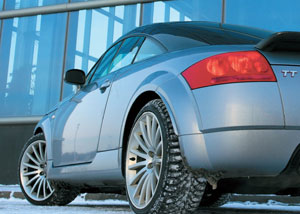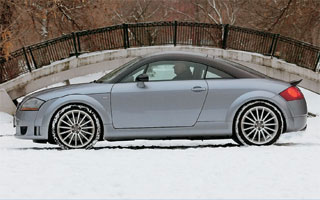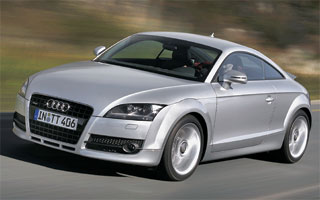Test drive Audi TT compartment 1998 - 2006 compartment
Neoclassica
 In the global auto industry there is a distinct tendency towards various kinds of mergers, associations and acquisitions. Perhaps the Volkswagen concern, which belongs to both Audi and the relatively modest Skoda and Seat, and recently, have prestigious Rolls -Royce, Bentley and Bugatti, succeeded. Next in line is Lamborghini ... The model gamut of the concern - from a tiny Lupo to the Rolls -Royce limousines - covers almost all market sectors.
In the global auto industry there is a distinct tendency towards various kinds of mergers, associations and acquisitions. Perhaps the Volkswagen concern, which belongs to both Audi and the relatively modest Skoda and Seat, and recently, have prestigious Rolls -Royce, Bentley and Bugatti, succeeded. Next in line is Lamborghini ... The model gamut of the concern - from a tiny Lupo to the Rolls -Royce limousines - covers almost all market sectors. The concern is currently trying to change its current image of the manufacturer, whose products are intended mainly for the average buyer. The attack is primarily at the position of compatriots - BMW and Mercedes, which traditionally produce higher class cars.
Until last year, Volkswagen on the entire front was restrained by the lack of a small sports car in the gamut of the concern - a compartment or a relative - capable of attracting fans of acute driving. To defeat competitors, he would have to surpass the BMW Z3 and Mercedes SLK in running qualities, in addition, to be more functional and cost less.
 The task was not easy, but the gap was filled - last year a car was represented in Paris that could compete with the best world samples.
The task was not easy, but the gap was filled - last year a car was represented in Paris that could compete with the best world samples. The new concern car is produced under the Audi brand and, unlike models that are indicated by the letter with the number, has its own name, TT from the name of the classic Tourist Trophy race, which has been held annually in the UK, on \u200b\u200bthe island of Maine since 1905. (This technique was used by other manufacturers, for example, Porsche, whose legendary model 911 is also named after the sports competition - Carrera Pan America.)
The step is serious, because the sonorous name obliges - the car from birth is determined in the elite group of sports cars, where competition is no less acute than on real racing tracks. There should be no mistakes and flaws - it is not without reason from the moment the TT concept is demonstrated to the launch of the car into the series three years passed, by modern standards - a considerable period.
The coupe is based on the Golf IV platform, with a shortened base and an extended track. A hint of kinship with another Volkswagen products is a characteristic cool glass with roof racks leaving under the hood, as on Passat and the new Beetle.
Gamma of coloring TT is not rich, only three colors are silver, black and blue jeans. Obviously, for solidity: a yellowish or green car would hardly be taken seriously.
The first impression of the car - the authors of the project strictly followed the canons of the design of a classic sports car. However, this differs in most of the most noticeable new products of the last decade - many of them have in their appearance the elements of antiquity, and some are generally designed as the Rome of the famous models of the past.
 Strictly speaking, Audi TT is no exception. Many, for the first time seeing the car, will probably think: is this another new beetle? Yes, and Thomas Freeman, the author of the first version of TT, honestly admits that it was inspired by the forms of sports Auto Union Rekordwagen of the 30s, which is considered one of the most technologically advanced cars of the 20th century. At the same time, the design of TT is perceived completely fresh and modern. Pure straight lines of the middle part, circular semicircles of wheel arches and overhangs - all this resembles a geometric study.
Strictly speaking, Audi TT is no exception. Many, for the first time seeing the car, will probably think: is this another new beetle? Yes, and Thomas Freeman, the author of the first version of TT, honestly admits that it was inspired by the forms of sports Auto Union Rekordwagen of the 30s, which is considered one of the most technologically advanced cars of the 20th century. At the same time, the design of TT is perceived completely fresh and modern. Pure straight lines of the middle part, circular semicircles of wheel arches and overhangs - all this resembles a geometric study.  An interesting stylistic solution was found for the nose and stern - from the wheel arches to the edges of the bumper they are the same. It seems that if you wish, the headlight can be changed with the rear lights, the back and front are so similar.
An interesting stylistic solution was found for the nose and stern - from the wheel arches to the edges of the bumper they are the same. It seems that if you wish, the headlight can be changed with the rear lights, the back and front are so similar. In the profile, the car - with its rounded ends - seems a little heavy, and in any case does not make the impression of dynamic and fast. The stereotype is triggered, according to which a sports car should be smeared along the road. But if you look at the TT of three quarters, it is clear that due to the strong expansion of the body below the waist line and developed wheel arches, the compartment, as it were, creeps along the road, sticks to it. Aerodynamic characteristics - corresponding: Lob resistance coefficient - 0.34.
 As a leitmotif of the interior design, a drawing ... a filler neck of a gas tank, which is made, like a racing car, an aluminum ring with secret heads of bolts around the perimeter. On all controls of auxiliary equipment, air duct deflectors and instruments, there are stylized rims. The steering wheel, headman and the base of the gearbox and even door handles are also ringed.
As a leitmotif of the interior design, a drawing ... a filler neck of a gas tank, which is made, like a racing car, an aluminum ring with secret heads of bolts around the perimeter. On all controls of auxiliary equipment, air duct deflectors and instruments, there are stylized rims. The steering wheel, headman and the base of the gearbox and even door handles are also ringed.  Other interior details that migrated from a purely racing car are more functional: pedals - naked stainless steel with rubber stripes - provide excellent adhesion to the sole of any shoes, and deep bucket -shaped seats reliably hold the riders in the coolest turns. The aluminum structure in the front of the central console, judging by the strength of the mount, is really a power element that increases the longitudinal rigidity of the body.
Other interior details that migrated from a purely racing car are more functional: pedals - naked stainless steel with rubber stripes - provide excellent adhesion to the sole of any shoes, and deep bucket -shaped seats reliably hold the riders in the coolest turns. The aluminum structure in the front of the central console, judging by the strength of the mount, is really a power element that increases the longitudinal rigidity of the body. 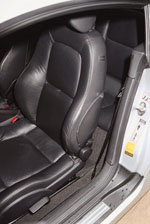 Adjusting the driver's seat - mechanical (the car I received for testing had the most modest equipment). The most comfortable driver pose is reclining, with a maximum support on the back of the chair. The steering wheel can be lowered almost to the knees. True, when leaving the car, it will have to be thrown up, but the latch is only one, and it is not difficult to do it.
Adjusting the driver's seat - mechanical (the car I received for testing had the most modest equipment). The most comfortable driver pose is reclining, with a maximum support on the back of the chair. The steering wheel can be lowered almost to the knees. True, when leaving the car, it will have to be thrown up, but the latch is only one, and it is not difficult to do it. 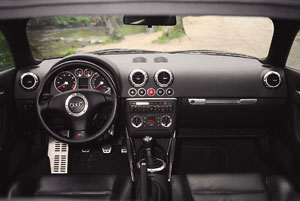 The bagel from the stop to the stop performs a little less than two and a half revolutions. This is a typical feature of a sports car - for the speed of maneuvering. But the pedal node, most likely, is taken from Golf without alteration - short -flowing brake and gas are brought together, you can only work with the right foot, but the clutch has a fairly long move and works in its upper part. Nonsens - a thorough stylization of the interior for the cockpit of the car, and suddenly such a puncture with pedals. Maybe this is done specifically so as not to provoke the driver to sports experiments? After all, it is difficult to predict how a powerful machine, stuffed with electronic stabilizing systems, will behave, while pressing an accelerator and a brake pedal.
The bagel from the stop to the stop performs a little less than two and a half revolutions. This is a typical feature of a sports car - for the speed of maneuvering. But the pedal node, most likely, is taken from Golf without alteration - short -flowing brake and gas are brought together, you can only work with the right foot, but the clutch has a fairly long move and works in its upper part. Nonsens - a thorough stylization of the interior for the cockpit of the car, and suddenly such a puncture with pedals. Maybe this is done specifically so as not to provoke the driver to sports experiments? After all, it is difficult to predict how a powerful machine, stuffed with electronic stabilizing systems, will behave, while pressing an accelerator and a brake pedal. The instrument shield is also not equipped like in a real sports car. It is felt that the machine is designed for a wide range of consumers - teapots including. But there were times when most of the serial Audi 80, not even decorated with Motorsport nameplate, installed pressure and oil temperature sensors, voltage of the on -board network, and on turbocharged machines - boost pressure.
 In the center of the torpedo there are climate controls with a liquid crystal display, above it is a panel made of polished aluminum with large letters of TT. If you press the panel, it rises, opening access to the audio system. Depending on the level of configuration, four music options can be installed in the machine. The first three are tape recorders with a radio, different in class, the latter is a radio plus a CD player. I did not turn on the music - I did not want an extraneous noise to drown out the engine song. And there was something to listen!
In the center of the torpedo there are climate controls with a liquid crystal display, above it is a panel made of polished aluminum with large letters of TT. If you press the panel, it rises, opening access to the audio system. Depending on the level of configuration, four music options can be installed in the machine. The first three are tape recorders with a radio, different in class, the latter is a radio plus a CD player. I did not turn on the music - I did not want an extraneous noise to drown out the engine song. And there was something to listen! The point is not at volume - the level of noise published by the car is strictly limited by current standards. With a noise they are fighting a merciless struggle. The motor of any modern car, no matter how powerful it is, works quietly in itself, and sounds that cannot be eliminated with structural tricks are suppressed by all kinds of insulating casings, coatings and overlays. Doupery also improve. But how can you deprive the driver of a sports car of pleasure to evaluate your herd under the hood by ear?
Manufacturers of sports cars use the only remaining loophole - the acoustic setting of the exhaust path (recently it has become especially fashionable). Within the permitted number of decibels, no one forbids the designers to add bass, simulate the howl of a formula motor or a compressor whistle ...
 Above the exhaust path of Audi TT, acoustics worked on fame. At idle, the car is not heard at all, but it is worth adding a little to the gas, as the rumble is heard, similar to distant peals of thunder. With an increase in the number of revolutions, the sound becomes higher and louder, and after 3000 rpm. A rattling whistle is added to it, indicating the inclusion of the turbine.
Above the exhaust path of Audi TT, acoustics worked on fame. At idle, the car is not heard at all, but it is worth adding a little to the gas, as the rumble is heard, similar to distant peals of thunder. With an increase in the number of revolutions, the sound becomes higher and louder, and after 3000 rpm. A rattling whistle is added to it, indicating the inclusion of the turbine. Having repaid the plenty of on the spot, I set off on the road. Remembering that under the hood of TT - 180 hp, I release the clutch more likely ... The site at the car dealership that provided the car is paved with tiles, and - despite the meager speed - it immediately feels that the suspension of the car is really sports, comparable in softness in softness With a bench. In addition, the wheels (17 inches) are shod in tires of the 45th series.
Having shook around the site, I taxi on even asphalt. The suburban road, passing through a highly crossed area, was looked after in advance, but in order to get on it, I had to put around the city. It turned out very quickly that neither semi -native landing, nor narrow glasses contribute to a good overview - to evaluate, more tolerably, it does not pull. Wide, falling under the sharp corners of the roof racks create dead areas on the right and left to the left. If the situation behind the car can still be controlled by looking at the outer mirror, then when leaving for each intersection you have to go forward and twist your head so as not to call the obstacle to the left.
The visually you like the design on the central console, most likely, will conflict with the driver’s right foot (if it is long enough). For urban driving, the seat is too clamping, and a large rider may seem crowded.
Another uncomfortable circumstance is the need to constantly look at the speedometer, since the speed in the car is not felt. It seems that you just started off the traffic light and do not go very quickly, but it turns out that the arrow is already sneaking up to a hundred.
 Having left the city, I relieve the gas pedal to the floor with relief. As if hungry for speed, the car is rapidly accelerating - wanting to support its impulse, I barely manage to cross the programs. To obtain maximum return from the turbocharged engine, its turnover should not be discarded below 4.5 thousand.
Having left the city, I relieve the gas pedal to the floor with relief. As if hungry for speed, the car is rapidly accelerating - wanting to support its impulse, I barely manage to cross the programs. To obtain maximum return from the turbocharged engine, its turnover should not be discarded below 4.5 thousand. According to the passport, acceleration to hundreds occupies a modest 7.4 second from the Audi TT, but the starting breakthrough makes you feel the headrest. After a few more seconds, the speedometer shows 230 km/h, and the tachometer arrow rests on the border of the red zone. Ahead is a smooth turn. I enter it, dropping speed up to 200 km/h - exactly so much as to leave the reserve for the release. The car rolls on a perfectly correct arc, without the slightest hint of demolition or roll.
The road straightens, weaken the pressure on the steering wheel and again lift the gas pedal. The numbers on the electronic odometer flicker - as if the stopwatch counts the fraction of a second. The forest and the abundance of deaf multidirectional turns in front forced to reduce speed to reasonable 120-130 km/h. At such a speed, the normal road turns into a slalom route - you have to shift the steering wheel as often as if you are passing a snake. The obedience of the car is excellent. When flying out on the descent, you have to work a little with the brake pedal, since the inertia of the turbine does not allow the speed to drop sharply after the gas discharge, and braking by the engine is not very effective. On the rise, to maintain a given speed, it is just enough to tackle a little bit.
The elasticity and traction of the engine are wonderful. Moving uphill in the fourth gear, I specially dropped the momentum to 2 thousand, after which I tried to accelerate. Even before the turbine is turned on (it occurs in the region of 2800-3000 rpm.) The car remains very frisky, and even after - the former hurricane, regardless of any rise.
 For the test I got the easiest version of TT, with front -wheel drive and a small engine. Small is 1.8 liters, four in a row, 20 valves and turbocharges. Power - 180 hp There is also a large engine, the same volume and design, but 45 horses are more powerful.
For the test I got the easiest version of TT, with front -wheel drive and a small engine. Small is 1.8 liters, four in a row, 20 valves and turbocharges. Power - 180 hp There is also a large engine, the same volume and design, but 45 horses are more powerful. The transmission is proposed only mechanical, 5-speed for 180-horsepower and 6-for a 225-horsepower engine. There is a version of TT with all -wheel drive. Regardless of the wheeled formula, the car is equipped with an electronic control differential: Interssev (4x4) or inter -circle (4x2).
The ease of control, the sensitivity of the steering wheel and the striking stability of the machine allow you to follow the desired trajectory with an accuracy of a millimeter and change it with lightning speed if necessary.
The suspension, as already noted, is very stringent and short -term, nevertheless, the elasticity with which the car overcomes various irregularities does not cause discomfort and does not tire.
Pleasantly struck the clarity of the selection of programs. I read about a new mechanism designed for TT, but reality exceeded expectations - the lever moves like a bolt in a rifle: quickly, briefly, with excellent fixation. When switching, it would be possible to win a few more moments by reducing the course of the clutch pedal, but this work, apparently, was left for tuning companies.
Brakes on all wheels are disk. The effectiveness of their operation fully corresponds to the temperament of the car. The mandatory package of TT includes ABS. In front -wheel drive machines, it is combined with a disconnected anti -circus system. With a sharp start from under the dashboard, a short signal is heard, informing that the APS worked and as if warning: attention! Spring is possible!.
 Having pretty much flesh along different roads, I stop in a picturesque place for shooting and further studying the car. Most of all were interested in the capabilities of the rear seat. Throwing back the front back to the steering wheel, I try to climb into the open narrow opening. It was difficult to do this, and after the driver's chair returned to its original position, I appreciated the meaninglessness of this step - it is impossible to stay behind an adult. The knees have to be attached in the lumen between the backs of the front seats or just climb onto the seat with legs. And if you still try to sit behind the driver (or his neighbor), having strongly squeezed him, and try to straighten up, his head will fall into the glass of the rear door. By the way, the picture is on it - a warning that before closing should pay attention to those sitting from behind. So for traveling TT is not adapted in any way. But together you can leave at least to the ends of the world - the spaciousness over the heads of the front passengers is impressive, and the volume of the trunk will load a sufficient amount of luggage. And if you also fold the backs of the rear sofa forward, then a snowboard and a bicycle will fit without problems.
Having pretty much flesh along different roads, I stop in a picturesque place for shooting and further studying the car. Most of all were interested in the capabilities of the rear seat. Throwing back the front back to the steering wheel, I try to climb into the open narrow opening. It was difficult to do this, and after the driver's chair returned to its original position, I appreciated the meaninglessness of this step - it is impossible to stay behind an adult. The knees have to be attached in the lumen between the backs of the front seats or just climb onto the seat with legs. And if you still try to sit behind the driver (or his neighbor), having strongly squeezed him, and try to straighten up, his head will fall into the glass of the rear door. By the way, the picture is on it - a warning that before closing should pay attention to those sitting from behind. So for traveling TT is not adapted in any way. But together you can leave at least to the ends of the world - the spaciousness over the heads of the front passengers is impressive, and the volume of the trunk will load a sufficient amount of luggage. And if you also fold the backs of the rear sofa forward, then a snowboard and a bicycle will fit without problems. Finally, I decide to look under the hood. It was possible not to do this, since all the units, including the engine, are covered with plastic shields. Having dismantled the central one, I see only the valve cover of the engine with separate coils for each candle, and somewhere below, between the motor and the body, the snail of the turbocharger.
The test program is completed, it's time to return the car to the car dealership - unfortunately. With pleasure I grab at the maximum on the way to the city, trying to remember for a long time a stunning sense of power over speed and road, which gives a powerful and obedient compartment - Audi TT. It remains to wait for a meeting with the Rodster, which has already been shown in Geneva.
Text: Evgeny Romatovsky
Source: Magazine Motor
Video Crash tests Audi TT compartment 1998 - 2006
Audi TT TT POM TT CUP 1998 - 2006
Crash test Audi TT compartment 1998 - 2006
Krassh Test: Detailed Information28%
Driver and passengers







